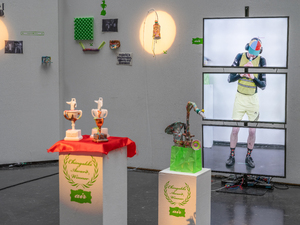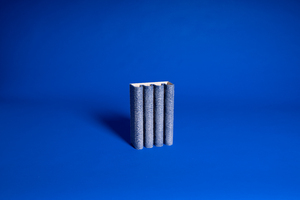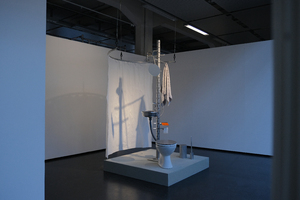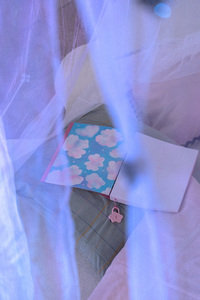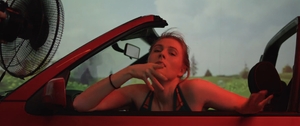Fabian Düss
| Name | Fabian Düss |
5 Inhalte
- Seite 1 von 1
Plastic Fugue
- Titel
- Plastic Fugue
- Titel (en)
- Plastic Fugue
- Autor/in
- Beschreibung (de)
- Plastic Fugue ist eine interaktive Klanginstallation, die mit einer Kindheitserinnerung an die Konzertflöte beginnt, ein Instrument, das ich aufgrund finanzieller Schwierigkeiten nie erlernen konnte und das für mich zum Symbol des Klassismus wurde. Finanzielle Einschränkung ist nicht nur unangenehm, sondern lässt Kinder sich als ungeeignet empfinden, überhaupt etwas zu versuchen, und normalisiert dadurch Klassismus, selbst in der Kunst.
Es passierte mir erneut, als ich Malerei studierte. Die Materialien, Leinwand, Holz, Stoff, Papier, Farbe, Öl, ja sogar ein Bleistift, werden mit einer gewissen Aura vermarktet. Unsere Kunst ist längst zu sehr mit der neoliberalen Wirtschaft verstrickt, ironischerweise im Widerspruch zu ihrem eigentlichen Ziel, Freiheit. Die Qualität von Kunst über den Preis der Materialien zu definieren, ist eine Wiederholung alter Muster, so wie Blau und Grün einst als Zeichen des Reichtums galten und dem Adel vorbehalten waren.
Diese Struktur führte dazu, dass ich klassische Musik als die einzig wahre Musik betrachtete und die Leinwandmalerei, die im späten 15. Jahrhundert in Italien entstand, als den allein gültigen Standard in der bildenden Kunst. Jahrzehnte später erkannte ich, dass es jenseits dessen, was ich damals als Kunst verstand, auch Formen gab, die aus verschiedenen kulturellen Kontexten stammen und nicht als Teil dieses Standards wahrgenommen wurden. Dann versuchte ich, all diese ironischen Elemente in die verschiedenen Medien einzubringen, mit denen ich bisher gearbeitet hatte.
- Plastic Fugue ist eine interaktive Klanginstallation, die mit einer Kindheitserinnerung an die Konzertflöte beginnt, ein Instrument, das ich aufgrund finanzieller Schwierigkeiten nie erlernen konnte und das für mich zum Symbol des Klassismus wurde. Finanzielle Einschränkung ist nicht nur unangenehm, sondern lässt Kinder sich als ungeeignet empfinden, überhaupt etwas zu versuchen, und normalisiert dadurch Klassismus, selbst in der Kunst.
- Beschreibung (en)
- Plastic Fugue is an interactive sound installation project that begins with a childhood memory of the concert flute, which I couldn't learn due to financial hardship, and which came to symbolize classism to me. Being financially debilitated is not only a discomfort, but also makes children feel unqualified to even try, thereby normalizing this classism even in art.
It happened to me again when I studied painting. The materials are marketed with an aura, including canvas, wood, fabric, paper, paint, oil, and even a pencil. Our art already conspires too much with the neoliberal economy, ironically, against its supposed goal: liberty. Classifying the quality of art based on the price of materials is repetitive, much like how blue and green, once symbols of wealth, were valued and reserved for royalty in history.
This structure led me to view classical music as the only true form of music, and canvas painting, which originated in Italy in the late 15th century, as the sole standard in visual art. Decades later, I realized there was more art behind the things I once believed to be art alone. Then I attempted to gather all these ironical elements into diverse mediums I had experienced so far.
- Plastic Fugue is an interactive sound installation project that begins with a childhood memory of the concert flute, which I couldn't learn due to financial hardship, and which came to symbolize classism to me. Being financially debilitated is not only a discomfort, but also makes children feel unqualified to even try, thereby normalizing this classism even in art.
- Kategorie
- Typ des Projekts/Werks
- Schlagworte
- Datierung
- 09.07.2025 - 13.07.2025
- Mitwirkende
- Dank an
- Material
- Abmessungen
- Variable Maße
- Dauer
- Introducing air&dust: 9' 11" / Sax Recital: 16' 37"
- Ort: Institution
- Ort
- Lichthof
- Stadt
- Land
- Internetlinks
- Titel
- Plastic Fugue
- Projektleiter/in
- Semester
- Studiengang
- Typ der Abschlussarbeit
- Importiert am
- 29.06.2025
- Übergeordnete Sets
- 2
- Set enthält
- 4 1
Wavebreaker
- Titel
- Wavebreaker
- Titel (en)
- Wavebreaker
- Untertitel
- Schallabsorbierende Fliesen
- Untertitel des Projekts/Werks (en)
- Sound absorbing tiles
- Autor/in
- Beschreibung (de)
- Wavebreaker ist ein modulares Fliesensystem, das entwickelt wurde, um Lärm in U-Bahn-Stationen wirksam zu reduzieren und die Aufenthaltsqualität spürbar zu verbessern. Die aus robuster Keramik gefertigten Fliesen werden im 3D-Druckverfahren hergestellt und lassen sich dadurch flexibel an verschiedene räumliche Situationen anpassen. Ihre Form orientiert sich an Schallwellen, wodurch sie nicht nur akustisch, sondern auch visuell zur Beruhigung des Raumes beitragen. Unterstützt wird dieser Effekt durch eine blaue Glasur, welche die ruhige Wirkung zusätzlich verstärkt.
Die schallabsorbierende Wirkung entsteht durch integrierte Helmholtz-Resonatoren und Schalldiffusoren, welche gezielt bestimmte Frequenzen aufnehmen, ohne dass poröse Materialien notwendig sind. Dies geschieht, indem der Schall in kleine Schlitze der Fliese eindringt und im Inneren in Hohlkammern resoniert und somit gedämpft wird. So wird der Umgebungslärm effektiv verringert, was zu einer entspannteren Atmosphäre im oft hektischen U-Bahn-Alltag führt. Dank ihres modularen und anpassungsfähigen Aufbaus eignen sich die Fliesen sowohl für Neubauten als auch für die Nachrüstung bestehender Stationen.
- Wavebreaker ist ein modulares Fliesensystem, das entwickelt wurde, um Lärm in U-Bahn-Stationen wirksam zu reduzieren und die Aufenthaltsqualität spürbar zu verbessern. Die aus robuster Keramik gefertigten Fliesen werden im 3D-Druckverfahren hergestellt und lassen sich dadurch flexibel an verschiedene räumliche Situationen anpassen. Ihre Form orientiert sich an Schallwellen, wodurch sie nicht nur akustisch, sondern auch visuell zur Beruhigung des Raumes beitragen. Unterstützt wird dieser Effekt durch eine blaue Glasur, welche die ruhige Wirkung zusätzlich verstärkt.
- Beschreibung (en)
- Wavebreaker is a modular tile system designed to effectively reduce noise in subway stations and noticeably improve the quality of stay. The tiles are made of durable ceramic and produced using 3D printing, which allows them to be flexibly adapted to different spatial conditions. Their shape is inspired by sound waves, helping to calm the environment not only acoustically but also visually. This effect is further supported by a blue glaze, which enhances the overall sense of calm.
The sound-absorbing effect is achieved through integrated Helmholtz resonators and sound diffusers, which target and absorb specific frequencies without the need for porous materials. This happens as sound enters small slits in the tile and resonates within internal cavities, where it is effectively dampened. As a result, ambient noise is significantly reduced, leading to a more relaxed atmosphere in the often hectic environment of subway stations. Thanks to their modular structure, the tiles are suitable for both new constructions and the retrofitting of existing stations.
- Wavebreaker is a modular tile system designed to effectively reduce noise in subway stations and noticeably improve the quality of stay. The tiles are made of durable ceramic and produced using 3D printing, which allows them to be flexibly adapted to different spatial conditions. Their shape is inspired by sound waves, helping to calm the environment not only acoustically but also visually. This effect is further supported by a blue glaze, which enhances the overall sense of calm.
- Kategorie
- Typ des Projekts/Werks
- Schlagworte
- Datierung
- 2024
- Dank an
- Material
- Technik/Verfahren/Formate
- Keramik 3D-Druck
- Abmessungen
- 15cm x 25cm x 5cm
- Ort: Institution
- Stadt
- Land
- Titel
- Wavebreaker
- Projektleiter/in
- Semester
- Studiengang
- Importiert am
- 26.06.2025
- Übergeordnete Sets
- 1
- Set enthält
- 0 16
Aqua Logistik
- Titel
- Aqua Logistik
- Titel (en)
- Aqua logistics
- Autor/in
- Beschreibung (de)
- Aqua Logistik ist ein Konzept für ein alternatives Badezimmer. Im Mittelpunkt des Entwurfs steht eine Säule, die gleichzeitig als Wasserverteilungssystem dient. Durch das Einsetzen von Komponenten in die perforierte Säule können die Nutzer das Bad nach ihren Bedürfnissen gestalten. Durch die Vereinfachung und Minimierung des Wassermanagements fördert das System einen direkteren Umgang mit der wertvollen Ressource Wasser.
Der modulare Aufbau ermutigt zu unterschiedlichen Reinigungsroutinen und lädt dazu ein, die Gewohnheiten im Bad zu überdenken - und fördert so einen intelligenteren Umgang mit Wasser im privaten Bereich. Die Grundlage für dieses Konzept bildet eine selbst durchgeführte Untersuchung und Umfrage, die in einer Publikation mit dem Titel veröffentlicht wurde: „May I ask you some Questions about your Bathroom usage“.
- Aqua Logistik ist ein Konzept für ein alternatives Badezimmer. Im Mittelpunkt des Entwurfs steht eine Säule, die gleichzeitig als Wasserverteilungssystem dient. Durch das Einsetzen von Komponenten in die perforierte Säule können die Nutzer das Bad nach ihren Bedürfnissen gestalten. Durch die Vereinfachung und Minimierung des Wassermanagements fördert das System einen direkteren Umgang mit der wertvollen Ressource Wasser.
- Beschreibung (en)
- Aqua Logistics is a concept for an alternative bathroom. The design centers around a column that also serves as the water distribution system. By inserting components into the perforated column, users can customize the bathroom according to their needs. By simplifying and minimizing water management, the system fosters a more direct relationship with the valuable resource of water.
The modular setup encourages diverse cleaning routines and invites a rethinking of bathroom habits—ultimately promoting more intelligent water usage in private spaces. The base for this concepts relies on a self conducted research and survey, published in a book called: “May I ask you some Questions about your Bathroom usage“.
- Aqua Logistics is a concept for an alternative bathroom. The design centers around a column that also serves as the water distribution system. By inserting components into the perforated column, users can customize the bathroom according to their needs. By simplifying and minimizing water management, the system fosters a more direct relationship with the valuable resource of water.
- Kategorie
- Typ des Projekts/Werks
- Schlagworte
- Datierung
- 30.04.2025
- Mitwirkende
- Dank an
- Johannes Bauer
- Patricia Capalija
- Athina Chrisofakis
- Lukas Clark
- Lukas Dechau
- Fabian Düss
- Rustam Faradzev
- Hannes Holstein
- Chris Kabel
- Tobias Keilbach
- Alexander Knoppik
- Mikail Kolbasar
- Julian Kuf
- Stefan Legner
- Anouk Merceron
- Tim Miler
- Lea Möscheid
- Francesco Perale
- Jana Renger
- Sebastian Schäfer
- Sebastian Schilbach
- Susanne Schmitt
- Marlon Schüch
- Wieki Somers
- Yannik Thamm
- Thomas Traxler
- Leonard Wille
- Levi Zimmermann
- Material
- Abmessungen
- Breite: 150cm, Länge: 150cm, Höhe 220 cm
- Ort: Institution
- Ort
- Lichtbrücke
- Stadt
- Land
- Titel
- Aqua Logistik
- Projektleiter/in
- Semester
- Studiengang
- Typ der Abschlussarbeit
- Importiert am
- 16.06.2025
- Übergeordnete Sets
- 1
- Set enthält
- 0 16
eternal girlhood
- Titel
- eternal girlhood
- Untertitel
- oh my dreams
- Autor/in
- Beschreibung (de)
- “eternal girlhood” ist eine konzeptionelle Arbeit, welche aus einer Rauminstallation und einer Publikation besteht.
Ursprünglich in den Chinesischen Pavillons des Fasanengartens in Karlsruhe installiert, wurde der Raum mit der Handlung der Publikation durch Requisiten sowie ein selbst produziertes Musikstück verknüpft.
Das Projekt ermöglicht eine Reise in eine poetische Geschichte, inspiriert von persönlichen und kulturellen Themen wie Girlhood, Coming-of-Age und Growing Pains.
Die handgebundene Publikation mit glitzerndem und geprägtem Umschlag umfasst auf ca. 100 Seiten neben Serien analoger Schwarzweiß-Fotografie farbige Mittelformat-Fotos, begleitet von analogen Schnappschüssen und Illustrationen im Riso-Druck.
Zwischen Fotoserien und Illustrationen sind Songtexte sowie Skriptfragmente und Gedichte eingestreut, in Referenz zu Filmsequenzen aus Coming-of-Age-Geschichten. Es ergibt sich die zeitlose Skizze eines Mädchens, das Teil einer innig verbundenen Mädchengruppe ist.
Transparente Drucke von drei Mittelformat-Fotografien werden vom Fensterlicht erleuchtet und symbolisieren in Zusammenhang mit dem Buch unterschiedliche Kapitel der Geschichte.
Unter einem Baldachin, umgeben von funkelnd tanzenden Schmetterlingen, können Besucher*innen in diese Welt eintauchen und sind eingeladen, für einen Moment Teil von „eternal girlhood“ zu sein, fernab der Echtzeit.
- “eternal girlhood” ist eine konzeptionelle Arbeit, welche aus einer Rauminstallation und einer Publikation besteht.
- Beschreibung (en)
- “eternal girlhood“ is a conceptional artwork, blending a publication with its installation space.
Initially installed in the Chinese pavillons of the Fasanengarten in Karlsruhe, the space was connected to the story of the book through props and a musical sound score.
The project offers a journey into a poetic story, inspired by personal and cultural ideas on girlhood, coming of age and growing pains.
Handbound, wrapped in a glittery embossed dustcover, the publication features around 100 pages with multiple series of black and white film photography, medium format shots underlined by analog snapshots and Riso printed Illustrations. In between the chapters of photography and Illustrations, lyrics, fragments of script and poems are inserted in reference to movie sequences from coming of age stories. A timeless profile of a girl being part of girlhood and a deeply connected friendship is created.
Transparent prints of three medium format photos are illuminated by the windows’ natural light and symbolize different chapters of the story in combination with the book.
Underneath a canopy, surrounded by sparkling dancing butterflies, visitors can dive into this world and are invited to become part of “eternal girlhood“, away from modern reality.
- “eternal girlhood“ is a conceptional artwork, blending a publication with its installation space.
- Kategorie
- Typ des Projekts/Werks
- Schlagworte
- Datierung
- 05.07.2024
- Mitwirkende
- Dank an
- Sprache
- Material
- Technik/Verfahren/Formate
- Risographie, Digitaldruck, Mediumformat-Fotografie, Schreibmaschine, Laser, Prägung
- Abmessungen
- Fläche: ca. 5m x 5m, Höhe der Aufhängung ca. 3m
- Ort: Institution
- Ort
- Chinesische Pavilions des Fasanengarten
- Stadt
- Land
- Beteiligte Institution(en)
- Titel
- eternal girlhood
- Projektleiter/in
- Semester
- Studiengang
- Typ der Abschlussarbeit
- Importiert am
- 05.11.2024
- Übergeordnete Sets
- 3
- Set enthält
- 0 21
It's okay now
- Titel
- It's okay now
- Titel (en)
- It's okay now
- Autor/in
- Beschreibung (de)
- "It’s okay now" ist ein autobiografisches Werk, das durch die Praxis des Erinnerns die Herkunft und Identität der beiden Protagonistinnen hinterfragt, analysiert und miteinander vergleicht. Das Erinnern dient dabei nicht nur als Mittel der Reflexion, sondern auch als eine Form des Träumens und Verarbeitens von Vergangenem. Fiktionale Szenen und Archivmaterial verweben sich zu einer Erzählung, die persönliche und kollektive Erinnerungen miteinander verschmelzen lässt.
- Beschreibung (en)
- "It’s okay now" is an autobiographical work that, through the practice of remembering, questions, analyzes, and compares the origins and identities of the two protagonists. In this process, remembering serves not only as a tool for reflection but also as a form of dreaming and processing the past. Fictional scenes and archival material intertwine to create a narrative that fuses personal and collective memories.
- Kategorie
- Typ des Projekts/Werks
- Schlagworte
- Datierung
- 01.10.2024 - 04.10.2024
- Mitwirkende
- Dank an
- Sprache
- Untertitel (Film)
- Material
- Technik/Verfahren/Formate
- 3-Kanal-Video-Audio Rauminstallation
- Abmessungen
- Breite: 10m; Tiefe: 10m; Höhe 4,5m
- Dauer
- 45 min
- Ort: Institution
- Ort
- Großes Studio
- Stadt
- Land
- Beteiligte Institution(en)
- Titel
- It's okay now
- Projektleiter/in
- Semester
- Studiengang
- Typ der Abschlussarbeit
- Archiv-Signatur
- its okay now
- Importiert am
- 10.10.2024
- Übergeordnete Sets
- 2
- Set enthält
- 0 11
